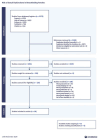Sexual Dysfunctions in Breastfeeding Females: Systematic Review and Meta-Analysis
- PMID: 39941367
- PMCID: PMC11818559
- DOI: 10.3390/jcm14030691
Sexual Dysfunctions in Breastfeeding Females: Systematic Review and Meta-Analysis
Abstract
Background: The prevalence of sexual dysfunctions varies from 35.5% to over 80% among postpartum women. Controversy exists regarding the risk factors for female sexual dysfunction (FSD) in the postpartum period. It remains unclear whether breastfeeding types contribute to the development of FSDs differently. Aims: The primary goal of this meta-analysis was to explore the role of baby feeding practices in developing sexual dysfunctions in women. Methods: We conducted a systematic literature search using the biomedical databases Scopus, CINAHL, Embase, the Web of Science, and PubMed/Medline. We looked for peer-reviewed, original studies written in English, Polish, and Arabic and published between January 2000 and June 2023. We included publications that reported scores in sexuality domains assessed with the Female Sexual Dysfunction Index (FSFI) and any sexuality-related issues during postpartum. The FSFI scores were combined in a meta-analysis using the random-effects inverse-variance model. Other findings were synthesized with a narrative review. Results: Eighteen articles met the eligibility criteria for the systematic review and meta-analysis. Sexual dysfunctions were detected in all the women, irrespective of the feeding type. Better overall sexual functioning was reported among women using complementary feeding than among those who breastfed exclusively or used baby bottles: 22.16, 95% CI [21.68; 22.65]; 21.61, 95% CI [20.27; 22.95]; and 20.18, 95% CI: [20.93; 61.30], respectively. Slightly lower scores were reported in all the FSFI subscales in exclusively breastfeeding women compared to those using the complementary method. Conclusions: Breastfeeding females experience difficulties in sexual life during the postpartum period, irrespective of the feeding type. These findings can help in designing preventive measures for tackling postpartum sexual dysfunctions in women.
Keywords: breastfeeding; lactation; meta-analysis; postpartum; sexual dysfunctions; sexual health; sexuality; women’s health.
Conflict of interest statement
The authors declare no conflicts of interest.
Figures








Similar articles
-
Risk of sexual dysfunctions in breastfeeding females: protocol for a systematic review and meta-analysis.BMJ Open. 2023 Aug 1;13(8):e074630. doi: 10.1136/bmjopen-2023-074630. BMJ Open. 2023. PMID: 37527888 Free PMC article.
-
The influence of partnership quality and breastfeeding on postpartum female sexual function.Arch Gynecol Obstet. 2019 Jan;299(1):69-77. doi: 10.1007/s00404-018-4925-z. Epub 2018 Oct 16. Arch Gynecol Obstet. 2019. PMID: 30327862
-
The Association Between Infant Feeding Methods and Female Sexual Dysfunctions.Breastfeed Med. 2021 Jan;16(1):93-99. doi: 10.1089/bfm.2020.0256. Epub 2020 Oct 21. Breastfeed Med. 2021. PMID: 33090011
-
Is There an Association Between Contraception and Sexual Dysfunction in Women? A Systematic Review and Meta-analysis Based on Female Sexual Function Index.J Sex Med. 2020 Oct;17(10):1942-1955. doi: 10.1016/j.jsxm.2020.06.008. Epub 2020 Jul 18. J Sex Med. 2020. PMID: 32694069
-
Female sexual dysfunction after bariatric surgery in women with obesity: A systematic review and meta-analysis.Scand J Surg. 2022 Jan-Mar;111(1):14574969211072395. doi: 10.1177/14574969211072395. Scand J Surg. 2022. PMID: 35253540
References
-
- WHO Sexual Health and Well-Being. [(accessed on 5 October 2024)]. Available online: https://www.who.int/teams/sexual-and-reproductive-health-and-research-(s....
-
- American Psychiatric Association . Diagnostic and Statistical Manual of Mental Disorders. American Psychiatric Association; Arlington, VA, USA: 2013.
-
- McCabe M.P., Sharlip I.D., Lewis R., Atalla E., Balon R., Fisher A.D., Laumann E., Lee S.W., Segraves R.T. Incidence and Prevalence of Sexual Dysfunction in Women and Men: A Consensus Statement from the Fourth International Consultation on Sexual Medicine 2015. J. Sex Med. 2016;13:144–152. doi: 10.1016/j.jsxm.2015.12.034. - DOI - PubMed
Publication types
Grants and funding
LinkOut - more resources
Full Text Sources
Miscellaneous

